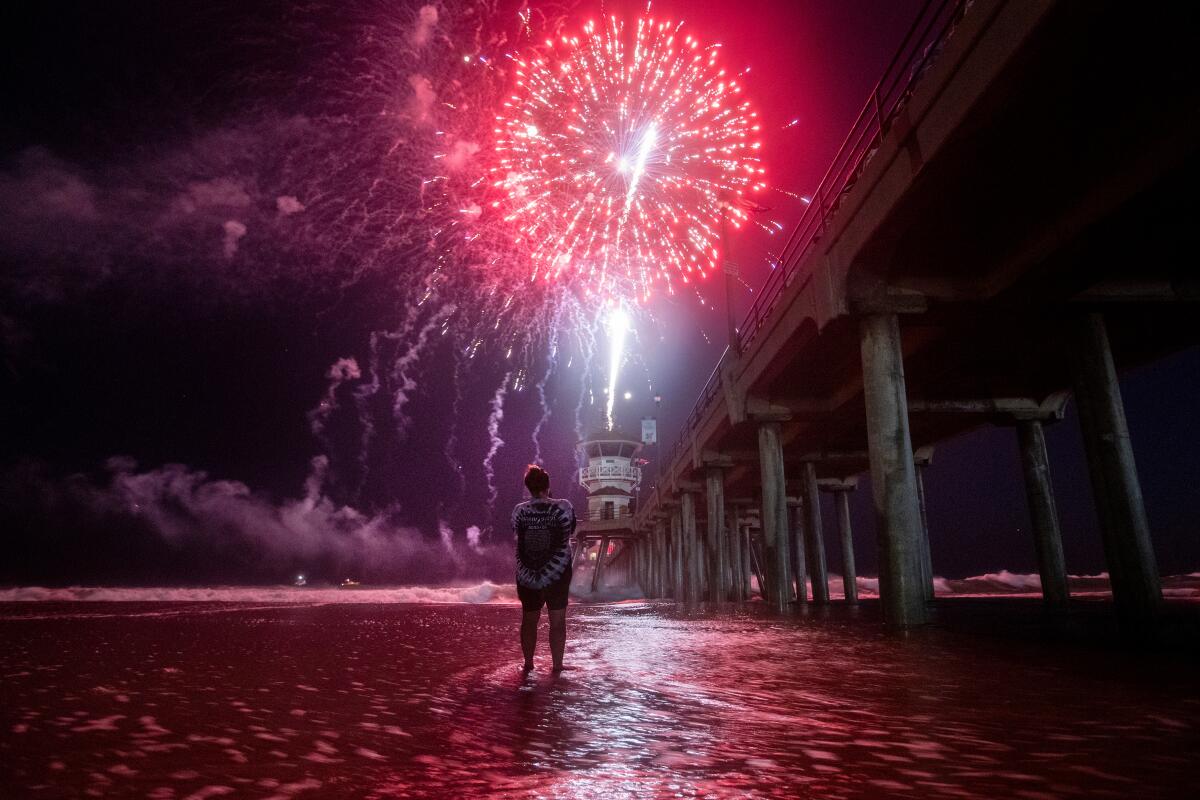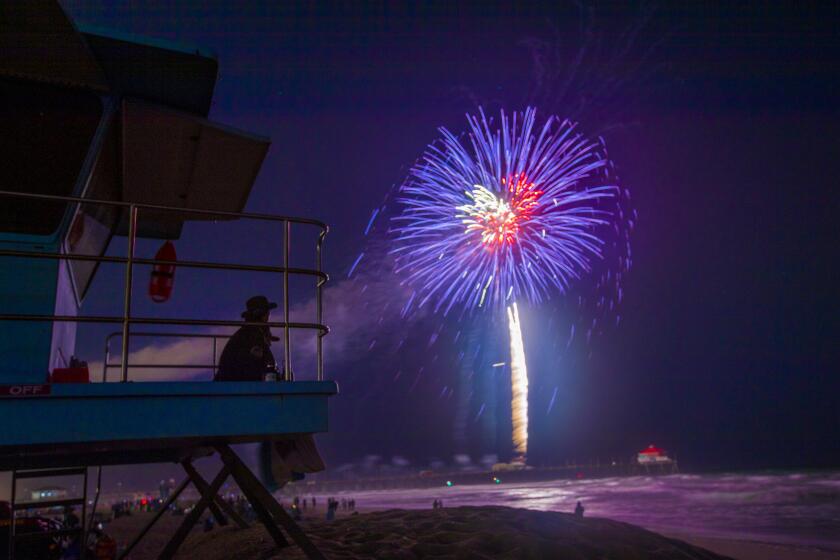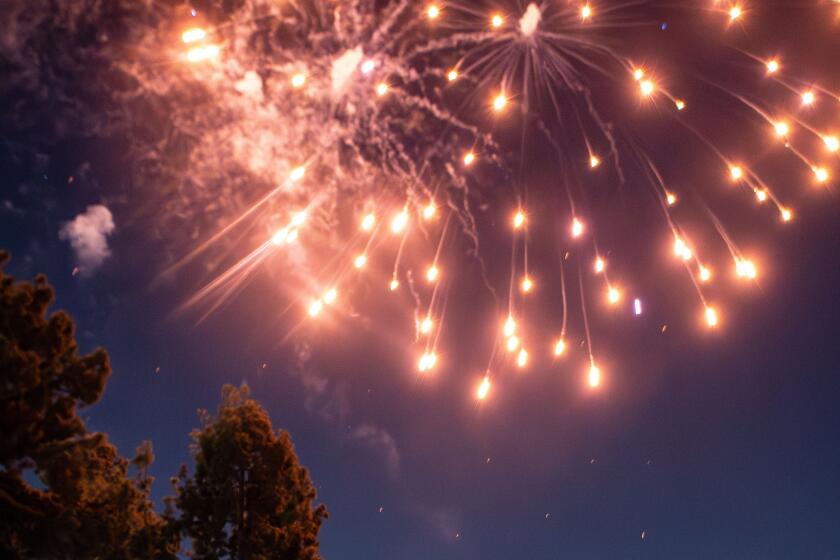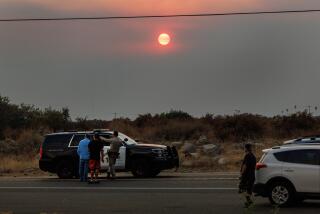Breath taking: July 4th fireworks again bring terrible air quality to L.A. region

Dozens of fireworks shows and many smaller, street-level pyrotechnic bursts lighted up Southern California skies throughout the Fourth of July celebration Tuesday — leaving behind some of the poorest air quality in recent years.
“This year was one of the worst we’ve seen in the last decade,” Scott Epstein, air quality assessment program supervisor for the South Coast Air Quality Management District, said Wednesday. The agency’s analysis wasn’t yet complete, but he said initial data were looking particularly bad — though not quite to the levels recorded on Independence Day 2020.
Air quality monitors from Pasadena to Long Beach recorded unhealthful levels right around 10 p.m. Tuesday after measuring in mostly healthful levels for most of the day, according to the U.S. Air Quality Index. Over the next few hours, levels dropped into the hazardous range for some parts of the region, increasing the likelihood of adverse health effects.
Every year, the South Coast Air Quality Management District warns that the holiday’s colorful displays are expected to bring some of the worst air quality days of the year, as fireworks emit high levels of particle pollution and metal air pollutants. Both of those byproducts are known to bring negative health effects, the agency said. The air quality agency monitors air pollution in Los Angeles, Orange, San Bernardino and Riverside counties.
A few Los Angeles County holiday firework shows planned along the coast have been canceled over new environmental protections for waterways, but most will proceed.
Though a few coastal fireworks shows were canceled this year after a dispute over new environmental regulations aimed at protecting waterways, and some communities have switched to more environmentally friendly drone or light shows, fireworks have continued to have a significant effect on Southland skies.
“There’s a fair bit of year-to-year variation, but in general we see the fine particulate pollution throughout the South Coast having increased over the last five or 10 years,” Epstein said. “We are seeing kind of an upward trend.”
Without noticeable changes in weather or other events that can affect air quality — like wildfires — Epstein said the data likely mean that Southern California continues to see an increase in fireworks use. He said confirming that theory, though, can be difficult as a large portion of fireworks are illegal: All personal fireworks are illegal in the city of L.A., and they are highly limited in unincorporated areas of L.A. County.
As early as Wednesday — hours after most fireworks concluded — air quality in a few areas, including the eastern San Gabriel Valley and the San Bernardino area, rose to hazardous levels, which the U.S. air quality index considers the most concerning level.
The air quality in Glendora and parts of the Inland Empire, including Riverside and Rancho Cucamonga, remained in the “very unhealthy” level on the Air Quality Index on Wednesday morning, according to the South Coast Air Quality Management District. Much of the Los Angeles area remained in the unhealthful level.
Bombs bursting in air are being replaced by drone light shows, which probably are better for public health and the environment.
These levels indicate conditions in which everyone may experience some adverse health effects from the poor air quality, such as difficulty breathing or throat irritation, while sensitive groups, including pregnant people and those with asthma, should avoid spending time outdoors, according to the U.S. Environmental Protection Agency.
By Wednesday afternoon, much of the region had returned to moderate or good air quality readings, according to the air quality agency. Meanwhile, air in parts of the San Gabriel Valley remained unhealthful, and a swath of the Southland from downtown L.A. to the Inland Empire still had air quality that was considered unhealthful for sensitive groups.
Epstein said air pollution typically lingers longer in inland areas after fireworks because prevailing winds move air eastward — until that air is blocked by the mountains. Coastal regions will often see a spike in air pollution immediately after firework shows, but it quickly clears out, he said.
“Everything keeps moving inland, then the inland sites get a spike a little bit later,” Epstein said. “That’s when they start seeing the air that came from metropolitan L.A.”
The air quality district recommends people stay indoors, close windows and run air conditioning or air purifiers when air quality is poor. Epstein also recommended downloading the agency’s app to help monitor air pollution.
“We want the public to be aware of the strategies that they can use to protect their health during periods of poor air quality,” Epstein said, noting wildfires can cause similar concerns. “It’s important that the public is aware of when the air quality is poor because you can’t always see it; visibility is not always the best metric of how polluted things are.”
More to Read
Sign up for Essential California
The most important California stories and recommendations in your inbox every morning.
You may occasionally receive promotional content from the Los Angeles Times.













